Lawrence Edward Byrom was released from state prison at Huntsville in 1964 after serving fourteen years of a thirty-year sentence for robbery, burglary, and theft in 1950 (see Part 1).
 Byrom’s convict record.
Byrom’s convict record.
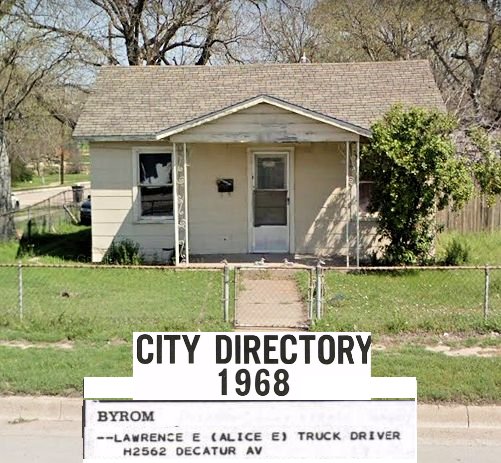 After a few months of freedom, in 1965 Larry Byrom married Alice Elizabeth Hart. He was thirty-six. She was sixteen. Like Larry, Alice had a limited formal education: the six grades of Tandy Elementary School on the East Side.
After a few months of freedom, in 1965 Larry Byrom married Alice Elizabeth Hart. He was thirty-six. She was sixteen. Like Larry, Alice had a limited formal education: the six grades of Tandy Elementary School on the East Side.
By 1968 Larry and Alice were living in a small house at 2562 Decatur Avenue. Like his father, Larry was a truck driver. For a while Larry and Alice operated their own trucking business. Both also drove trucks for a Dallas gravel company.
The first of their three sons was born in 1966, the second in 1970.
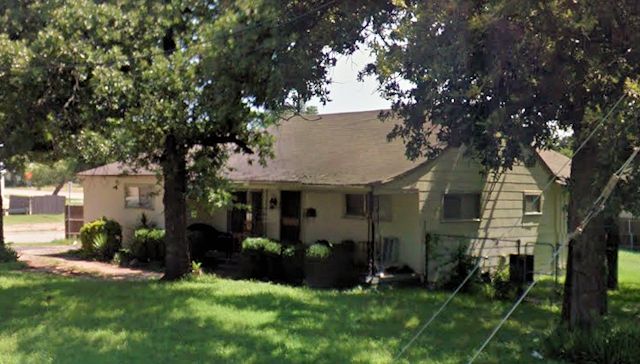 By 1971 the Bryoms had moved to a larger house at 2630 Oakwood Terrace in Haltom City. Their third son was born in 1971. Larry and Alice also bought a nine-acre ranch near Springtown.
By 1971 the Bryoms had moved to a larger house at 2630 Oakwood Terrace in Haltom City. Their third son was born in 1971. Larry and Alice also bought a nine-acre ranch near Springtown.
The Byroms kept to themselves, and their neighbors in both Haltom City and Springtown knew little about them.
And then, on the night of May 25, 1984, twenty years after Larry got out of prison, federal agents arrived at 2630 Oakwood Terrace with arrest warrants. Two days later neighbors of the Byroms read this on the front page of the Star-Telegram:
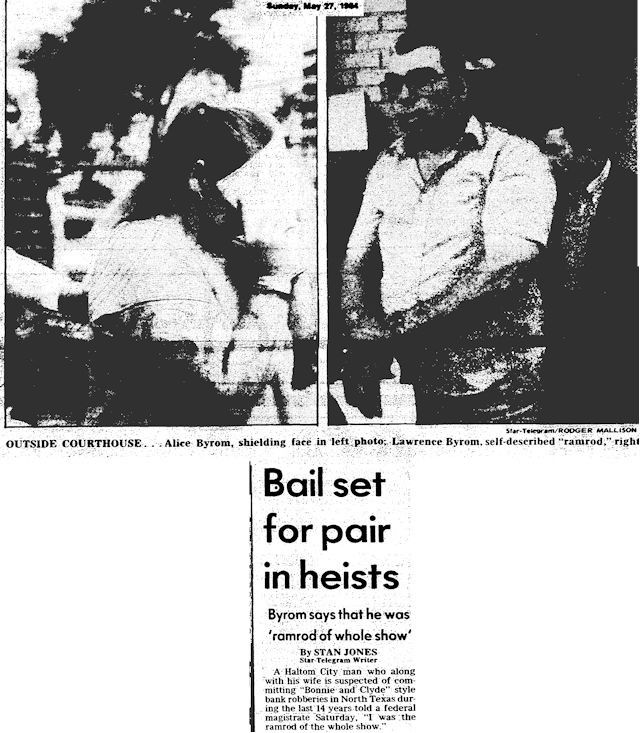 Larry and Alice Byrom had been leading a double life: Neighbors had known the couple as truck drivers. After the Byroms were arrested, law enforcement officers called Larry and Alice the “modern-day Bonnie and Clyde.” Like Bonnie and Clyde, Larry and Alice specialized in robbing banks in small towns in north Texas: fourteen banks in fourteen years (1970-1983), taking half a million dollars in all.
Larry and Alice Byrom had been leading a double life: Neighbors had known the couple as truck drivers. After the Byroms were arrested, law enforcement officers called Larry and Alice the “modern-day Bonnie and Clyde.” Like Bonnie and Clyde, Larry and Alice specialized in robbing banks in small towns in north Texas: fourteen banks in fourteen years (1970-1983), taking half a million dollars in all.
After the Byroms were arrested, Larry did not complain about the amount of his bail—$250,000—because “I was the ramrod of the whole show.” But he protested the amount of Alice’s bail—$100,000. “She’s got no record, and she’s also got three children,” he said. The judge sliced her bail in half.
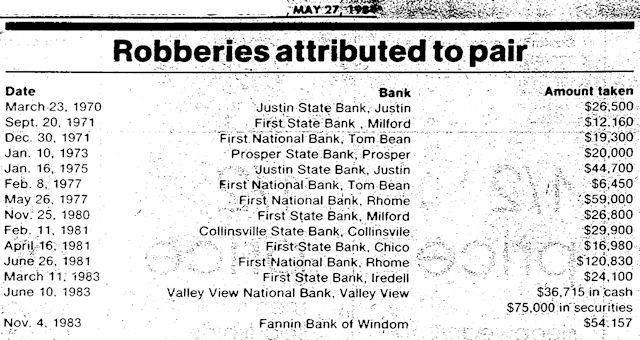 Note that Larry and Alice had robbed the banks in Milford, Justin, Tom Bean, and Rhome twice.
Note that Larry and Alice had robbed the banks in Milford, Justin, Tom Bean, and Rhome twice.
The Byrom MO: steal a car (usually from a new car dealership in the Metroplex) to drive to the bank, enter wearing ski masks and baggy clothing and armed with shotguns and automatic rifles; after the robbery abandon the stolen car in a rural area and switch to another vehicle.
Of the second Rhome robbery in 1981 Byrom later recalled: “I’ll never forget, we used a 1981 Z28 Camaro stolen from Durant Chevrolet in Granbury. Mosquitoes almost ate us up while we were waiting to steal this car.”
Despite the Byroms’ limited formal education, the couple had plenty of street smarts—enough to evade arrest for fourteen years. FBI agent Jim Adams said the Byroms “picked remote banks” with less security and used “good escape routes.”
Byrom also installed radio scanners in their getaway cars so the couple could monitor law enforcement communication. Byrom also had begun installing bulletproof steel plating in their getaway cars.
The Byroms were always armed during a robbery but never fired a shot, authorities said. Nonetheless, some authorities considered the Byroms to be “the most dangerous couple in Texas.”
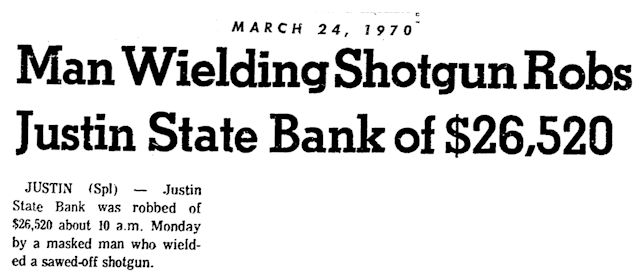 Their first job was Justin State Bank. Armed with a sawed-off shotgun, Byrom walked into the bank and demanded of bank president Newton Knox: “You go get the money out of the safe or you’re a dead man.”
Their first job was Justin State Bank. Armed with a sawed-off shotgun, Byrom walked into the bank and demanded of bank president Newton Knox: “You go get the money out of the safe or you’re a dead man.”
Byrom left the bank with $26,500.
But several people outside the bank were aware that a robbery was in progress and noted the license plate number of the getaway car, which the Byroms had stolen from Bill McDavid Pontiac. In addition, two local residents followed the getaway car and watched Byrom abandon it and get into a 1970 Ford Pickup, in which Alice and two sons were waiting.
 In 1975 Larry promoted Alice from lady-in-waiting to co-robber. When he walked into the Justin bank to rob it a second time, Alice walked in with him.
In 1975 Larry promoted Alice from lady-in-waiting to co-robber. When he walked into the Justin bank to rob it a second time, Alice walked in with him.
Bank president Newton Knox was talking on the phone when the Byroms, wearing ski masks and armed with a shotgun and a rifle, walked in. “We’ve got a robbery. Hang up and call the police,” Knox whispered into the phone. The Byroms demanded that Knox collect the money ($44,700) from the teller cages, the drive-through window, and the vault. Then the Byroms ordered the bank employees and customers to lie on the floor.
As in 1970, a witness to the robbery followed the getaway car, a 1975 Ford Torino, but lost it. The Byroms changed cars near Ponder and were able to slip through roadblocks set up by state and county law enforcement officers.
(I have no idea why the reporter described the Byroms, who were white, as “two black gunmen.”)
And note that witnesses described the two robbers as “men.” Law enforcement officers eventually suspected that the robbers were in reality a man and a woman.
And law enforcement officers eventually suspected that the man and woman were Larry and Alice Byrom: A witness had spotted and reported a stolen car at the Byroms’ ranch; a Texas Department of Public Safety officer driving on Loop 820 had spotted a truck similar to one that had been seen near an abandoned getaway car after a bank robbery. The truck was traced to Bryom.
Then came April 1984. By then the Byroms had been out of (legal) work for two years and were, Larry recalled, “really hurting for money” and had been “looking for a bank to rob for two weeks.”
“I wanted to rob the bank in Bryson [Jack County],” he told federal agents after the arrests, “but we were scared of it because we heard the sheriff’s office in Jacksboro talking over the radio about an alarm at the bank.”
On the day of their arrests, Larry told agents, “We were back around Bryson to look it [the bank] over again, and there were too many cars where there shouldn’t have been.”
Indeed by April 1984 the Byroms were under federal surveillance.
As Larry and Alice left Bryson to return home, an airplane that had been circling overhead followed them.
That night federal agents arrested the Byroms at their Haltom City home. At the two Byrom residences law enforcement officers seized shotguns, rifles, and pistols, ski masks, stolen cars and clothing, bulletproof vests, county maps, and police scanners.
The arrests surprised neighbors of the Byroms on Oakwood Terrace.
“I can’t believe it,” said one. “You could knock me over with a feather.”
Said another: “They seemed like real nice, quiet people. They never had anything wild going on over there, just kids playing in the yard and him and her working in the yard.”
The Byroms kept to themselves, neighbors said.
“Nobody neighbored with them,” said one neighbor. “They stayed to theirselves.”
But one neighbor said she had been suspicious of the Byroms because of their conspicuous consumption: a boat, an RV, numerous new cars and trucks.
“New trucks and this and that and motorcycles and bicycles—if you don’t have a regular job you just don’t do that too much,” the neighbor said.
 The statute of limitations had expired on the robberies committed in the 1970s, but Larry and Alice were charged with four bank robberies committed between 1980 and 1983.
The statute of limitations had expired on the robberies committed in the 1970s, but Larry and Alice were charged with four bank robberies committed between 1980 and 1983.
Husband and wife each faced up to 180 years in prison.
In 1985 Larry and Alice pleaded no contest and were found guilty. Larry was sentenced to fifty years in federal prison, Alice to twenty-five years.
 In 1987, two years after Larry Byrom went to prison, Star-Telegram writer Tony Slaughter died. During his forty-four years at the newspaper he had written about everything from Larry’s first crime spree to Colonial Country Club’s golf tournament. He also had been national chairman of the All-American Soap Box Derby and president of the state chapter of Sigma Delta Chi journalism society. In 1976 the city honored him with Tony Slaughter Day.
In 1987, two years after Larry Byrom went to prison, Star-Telegram writer Tony Slaughter died. During his forty-four years at the newspaper he had written about everything from Larry’s first crime spree to Colonial Country Club’s golf tournament. He also had been national chairman of the All-American Soap Box Derby and president of the state chapter of Sigma Delta Chi journalism society. In 1976 the city honored him with Tony Slaughter Day.
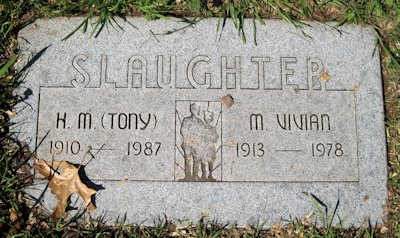 Harrison Milton (Tony) Slaughter is buried in Greenwood Cemetery.
Harrison Milton (Tony) Slaughter is buried in Greenwood Cemetery.
Five years after Slaughter died, Alice Byrom was paroled in 1992.
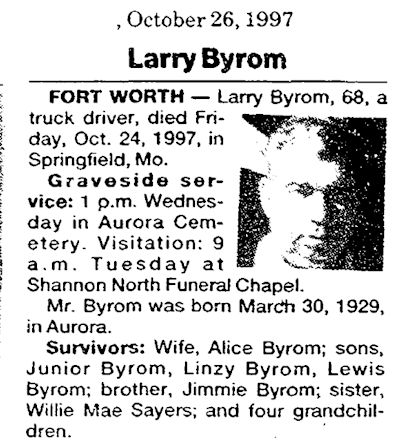 Five years after Alice Byrom was paroled, Larry Byrom’s fifty-year prison sentence was cut short—by death. On October 25, 1997 Lawrence Edward Byrom died at the United States Medical Center for Federal Prisoners in Springfield, Missouri. The man who forty-eight years earlier had said, “If you can’t serve time, don’t do crime” had served time for thirty of his sixty-eight years.
Five years after Alice Byrom was paroled, Larry Byrom’s fifty-year prison sentence was cut short—by death. On October 25, 1997 Lawrence Edward Byrom died at the United States Medical Center for Federal Prisoners in Springfield, Missouri. The man who forty-eight years earlier had said, “If you can’t serve time, don’t do crime” had served time for thirty of his sixty-eight years.
On a back page of the Star-Telegram on October 26, 1997 The Big Story of Lawrence Edward Byrom had become a little story.
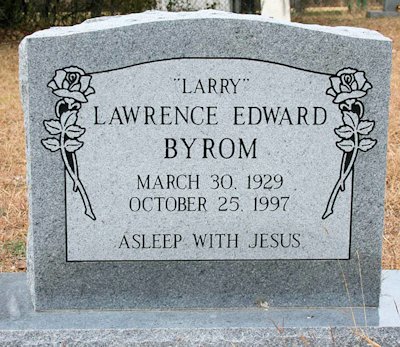 Larry Byrom, the “ramrod” of fourteen bank robberies in fourteen years, is buried in Aurora Cemetery in Wise County.
Larry Byrom, the “ramrod” of fourteen bank robberies in fourteen years, is buried in Aurora Cemetery in Wise County.
(Buried twelve miles west of Larry Byrom: George “Machine Gun” Kelly)





